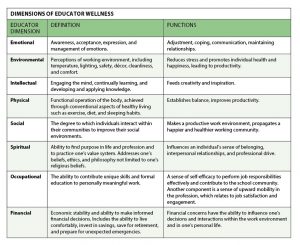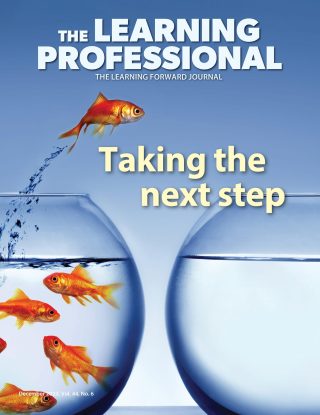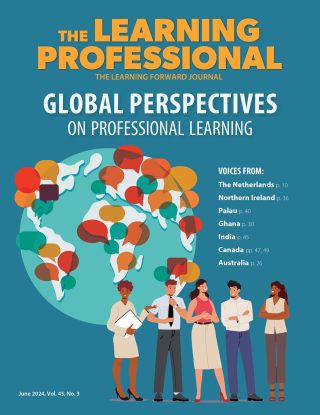Teaching is a selfless profession. Although many of us find great satisfaction in our work, most educators would probably say they are driven by the desire to help and inspire students. Too often, educators sacrifice their own well-being to support students’ social, emotional, and academic needs. We have experienced this ourselves and seen it among educators we have supported.
Teacher wellness influences school culture and climate, instruction, and students’ academic, personal, and emotional development (Sackney et al., 2000). It also affects the stability of the workforce.
''Teacher wellness influences school culture and climate, instruction, and students’ academic, personal, and emotional development.'' Share on XEducator burnout has increased in the United States over the past decade (Wang et al., 2015; Koenig et al., 2017), and it has been attributed to chronic strain that results from the mismatch between job demands and available resources to emotionally and mentally cope with the job demands (Lauermann & Konig, 2016). And over the last 40 years, teacher attrition rates in North America have increased from 30% to 40% (Wang et al., 2015).
Yet wellness has not been systematically explored within the field of education (Sackney et al., 2000), and teachers are often unaware of the few outlets that exist to explore their personal and emotional needs, such as counseling services, physical wellness memberships, and social support groups (Taxer & Frenzel, 2015). Clearly, there is a need for more emphasis on educators’ well-being.
If educators are focused on supporting the whole child, including social and emotional health, why aren’t we supporting the wellness of the whole educator? And what can we do about that?
Paying attention to the whole educator benefits students as well as adults. As their wellness needs will be met, educators will have more space to be engaged in equity work and teach in a more critically conscious manner.
''Paying attention to the whole educator benefits students as well as adults.'' #TheLearningPro Share on XDIMENSIONS OF EDUCATOR WELLNESS
Wellness is a multidimensional and holistic state of being that is conscious, self-directed, and focused on promoting and maximizing human potential (National Wellness Institute, n.d.). Wellness is the total integration of multiple dimensions (Morris & DeVane, 1994; Sackney et al., 2000).
We define educator wellness along eight dimensions described by the Substance Abuse and Mental Health Services Administration of the U.S. Department of Health and Human Services: emotional, environmental, intellectual, physical, social, spiritual, occupational, and financial. The eight dimensions are described in the table on p. 51, and in the following pages, we describe their relevance for educators and some strategies to address them.

Emotional wellness
Emotional wellness is a major component of an educator’s daily life because it affects interactions with students, parents, colleagues, and administrators. For example, educators often need to manage their personal feelings of frustration to deal positively with students’ challenging behaviors.
''Emotional wellness is a major component of an educator’s daily life because it affects interactions with students, parents, colleagues, and administrators.'' Share on XEducators can achieve emotional management and wellness through individual activities that allow for self-reflection and processing as well as maintaining connections with friends who are active listeners, trusted colleagues, mentors, coaches, or professionals who are trained in emotional wellness strategies.
Individual activities help, too — practicing mindfulness or meditation, partaking in a hobby, taking a leisurely walk in nature (Zurawik, 2020), or using journaling techniques to process through emotions (Pennebaker, 1997).
Educators may want to consider counseling when self-care techniques aren’t enough. Counseling gives the educator a safe space with a neutral party to make sense of emotions and gain clarity in how to make necessary life adjustments.
Environmental wellness
Because environmental wellness establishes the physical and mental foundation that grounds an educator’s work, administrators and systems must create and maintain environments that minimize stress for teachers and students and support overall wellness. School districts and school administrators need an environmental climate policy that supports teachers’ environmental wellness by providing maintained and controlled climates, including lighting, temperature, cleanliness, and access to immediate room repairs.
In our experience, even painting walls has positively influenced teachers and students’ moods and willingness to keep the environment cleaner.
Intellectual wellness
The pursuit of one’s intellectual passion is essential for educators’ relational and instructional engagement with students. It helps them stay current with evolving research and follow through with emerging best practices.
Schools are responsible for — and ultimately benefit from — cultivating an environment that helps employees pursue creativity and knowledge. Education systems need to provide educators with opportunities to continually expand their content knowledge and pedagogical practices, particularly in how to serve students in culturally responsive and equitable ways. High-quality professional learning is essential for nurturing intellectual well-being.
Physical wellness
Educators often feel so extended by the day-to-day demands of their professional and personal lives that they don’t make time for physical wellness. Educators who have a depleted sense of physical wellness are more susceptible to physical and mental illness, which has a direct influence on attendance, relationships, and capacity to serve students. In turn, this can have a negative impact on other educators and their ability to serve students.
School districts can support physical wellness by providing discounted gym memberships, access to school gyms with designated hours for educators to use district equipment, group exercise classes, or physical wellness challenges.
Social wellness
Social wellness provides the foundation for interaction and participation with and commitment to students, parents, and the community that are rooted in mutual respect, interdependence, and cooperation (Sackney et al., 2000; Strout & Howard, 2012).
Educators must engage in opportunities that allow them to interact and socialize with other individuals outside of the workplace to meet their social wellness needs. Schedules filled with evening athletic events, school community events, professional learning, and lesson planning can interfere with educators creating a healthy work-life balance.
Spiritual wellness
Spiritual wellness allows educators to find their purpose and passion within the profession, enabling them to serve students equitably. Spiritual wellness is unique to each individual in how he or she will cultivate the understanding to support this dimension. Educators can create the space for deepening their spiritual wellness by examining individual aspirations, looking for deeper meanings, and analyzing recurring patterns through reflective journaling, meditation, self-help book studies, and introspective mindfulness time.
Occupational wellness
Schools have a moral obligation to build educator capacity and to retain and value each educator as a contributing member of the collective school district. Educators’ occupational wellness is often threatened because of limited growth opportunities. For example, many educators believe that the only path for career advancement is administration — a pathway that doesn’t appeal to everyone.
Education systems must make clear to educators that there are many ways to contribute to the school and the field. A district’s professional learning or human resources department could provide seminars on possible advanced pathways by partnering with a local university to share training that is available for school instructional deans, school counselors, school psychologists, district office coordinators, and directors in areas such as curriculum, research and assessment, educational technology, and professional learning.
Financial wellness
Financial wellness has a direct effect on educators’ ability to support their life, health, and mental well-being. If an individual is under financial stress, this occupies an overwhelming amount of an individual’s mental capacity, preventing educators from being fully mindful and critically conscious in their instructional practices and relationships — a direct threat to achieving educational equity, because providing antiracist and equitable services requires one to be mindful and reflective of his or her actions.
HOW THEY INTERCONNECT
To support the whole educator, it is imperative to understand the eight dimensions individually and then examine how they are interconnected. There are steps that we can take in each domain and across domains.
To support the whole educator, it is imperative to understand the eight dimensions of educator wellness. #TheLearningPro Share on XIn our experience, this involves a blend of small and larger structural steps that education systems can take. For example, looking at financial wellness, a small step is shifting the payment schedule from 10 months to 12 months, making it easier to budget monthly expenses and plan for unexpected life situations on small salaries. Larger, more structural solutions include increasing teachers’ salaries and partnering with municipalities to provide affordable housing options. The latter is an example of an approach that addresses multiple wellness domains, including environmental and perhaps physical in addition to financial.
To support students equitably, we must support educators in a range of ways, large and small, so that they can achieve all eight dimensions of wellness. We are past due in attending to educator wellness, and every step counts.
References
Koenig, A., Rodger, S., & Specht, J. (2017). Educator burnout and compassion fatigue: A pilot study. Canadian Journal of School Psychology, 32, 1-20.
Lauermann, F. & Konig, J. (2016). Teachers’ professional competence and wellbeing: Understanding the links between general pedagogical knowledge, self-efficacy and burnout. Learning and Instruction, 45, 9-19.
Morris, R.C. & Devane, S. (1994). An “integrated” wellness model for effectively coping with stress in teaching. Thresholds in Education, 20, 30-34.
National Wellness Institute. (n.d.). The six dimensions of wellness. www.nationalwellness.org/page/Six_Dimensions
Pennebaker, J. (1997). Writing about emotional experiences as a therapeutic process. Psychological Science, 8(3),162-166.
Sackney, L., Noonan, B., & Miller, C.M. (2000). Leadership for educator wellness: An exploratory study. International Journal of Leadership in Education, 3, 41-56.
Strout, K.A. & Howard, E.P. (2012). The six dimensions of wellness: Cognition in aging adults. Journal of Holistic Nursing, 30, 195-204.
Taxer, J.L. & Frenzel, A.C. (2015). Facets of teachers’ emotional lives: A quantitative investigation of teachers’ genuine, faked, and hidden emotions. Teaching and Teacher Education, 49, 78-88.
Wang, H., Hall, N.C., & Rahimi, S. (2015). Self-efficacy and causal attributions in teachers: Effects on burnout, job satisfaction, illness, and quitting intentions. Teaching and Teacher Education, 47, 120-130.
Zurawik, M. (2020). Moving through spaces – leisure walking and its psychosocial benefits for well-being: A narrative review. Human Movement, 21(2), 1-8.
Recent Issues
WHERE TECHNOLOGY CAN TAKE US
April 2024
Technology is both a topic and a tool for professional learning. This...
EVALUATING PROFESSIONAL LEARNING
February 2024
How do you know your professional learning is working? This issue digs...
TAKING THE NEXT STEP
December 2023
Professional learning can open up new roles and challenges and help...
REACHING ALL LEARNERS
October 2023
Both special education and general education teachers need support to help...












